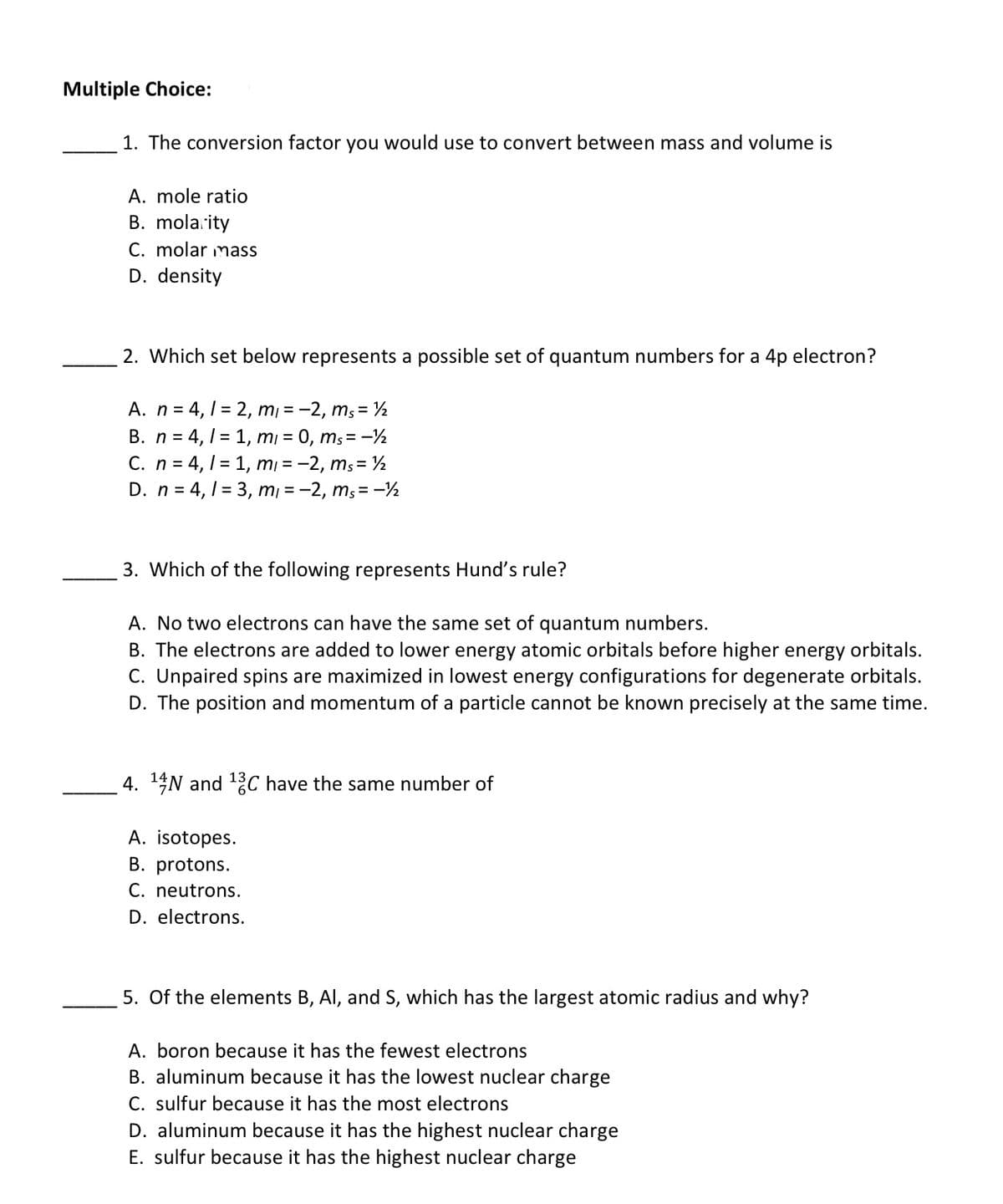1. The conversion factor you would use to convert between mass and volume is A. mole ratio B. mola ity C. molar mass D. density 2. Which set below represents a possible set of quantum numbers for a 4p electron? A. n = 4, 1 = 2, m = -2, ms = 2 B. n = 4, 1 = 1, mi = 0, ms=-½ C. n= 4, 1 = 1, mi = -2, ms= ½ D. n = 4, 1 = 3, m = -2, ms = -½ 3. Which of the following represents Hund's rule? A. No two electrons can have the same set of quantum numbers. B. The electrons are added to lower energy atomic orbitals before higher energy orbitals. C. Unpaired spins are maximized in lowest energy configurations for degenerate orbitals. D. The position and momentum of a particle cannot be known precisely at the same time.
1. The conversion factor you would use to convert between mass and volume is A. mole ratio B. mola ity C. molar mass D. density 2. Which set below represents a possible set of quantum numbers for a 4p electron? A. n = 4, 1 = 2, m = -2, ms = 2 B. n = 4, 1 = 1, mi = 0, ms=-½ C. n= 4, 1 = 1, mi = -2, ms= ½ D. n = 4, 1 = 3, m = -2, ms = -½ 3. Which of the following represents Hund's rule? A. No two electrons can have the same set of quantum numbers. B. The electrons are added to lower energy atomic orbitals before higher energy orbitals. C. Unpaired spins are maximized in lowest energy configurations for degenerate orbitals. D. The position and momentum of a particle cannot be known precisely at the same time.
Chemistry: The Molecular Science
5th Edition
ISBN:9781285199047
Author:John W. Moore, Conrad L. Stanitski
Publisher:John W. Moore, Conrad L. Stanitski
Chapter5: Electron Configurations And The Periodic Table
Section: Chapter Questions
Problem 141QRT
Related questions
Question

Transcribed Image Text:Multiple Choice:
1. The conversion factor you would use to convert between mass and volume is
A. mole ratio
B. molarity
C. molar mass
D. density
2. Which set below represents a possible set of quantum numbers for a 4p electron?
A. n = 4, 1 = 2, m = -2, ms= ½
B. n = 4,1= 1, mi = 0, ms= -½
C. n = 4,1 = 1, mi = -2, ms= ½
D. n = 4,1 = 3, m = -2, m, = -½
%3D
3. Which of the following represents Hund's rule?
A. No two electrons can have the same set of quantum numbers.
B. The electrons are added to lower energy atomic orbitals before higher energy orbitals.
C. Unpaired spins are maximized in lowest energy configurations for degenerate orbitals.
D. The position and momentum of a particle cannot be known precisely at the same time.
4. 14N and 13C have the same number of
A. isotopes.
B. protons.
C. neutrons.
D. electrons.
5. Of the elements B, Al, and S, which has the largest atomic radius and why?
A. boron because it has the fewest electrons
B. aluminum because it has the lowest nuclear charge
C. sulfur because it has the most electrons
D. aluminum because it has the highest nuclear charge
E. sulfur because it has the highest nuclear charge
Expert Solution
This question has been solved!
Explore an expertly crafted, step-by-step solution for a thorough understanding of key concepts.
This is a popular solution!
Trending now
This is a popular solution!
Step by step
Solved in 4 steps with 4 images

Knowledge Booster
Learn more about
Need a deep-dive on the concept behind this application? Look no further. Learn more about this topic, chemistry and related others by exploring similar questions and additional content below.Recommended textbooks for you

Chemistry: The Molecular Science
Chemistry
ISBN:
9781285199047
Author:
John W. Moore, Conrad L. Stanitski
Publisher:
Cengage Learning

Introductory Chemistry: A Foundation
Chemistry
ISBN:
9781337399425
Author:
Steven S. Zumdahl, Donald J. DeCoste
Publisher:
Cengage Learning

Chemistry: An Atoms First Approach
Chemistry
ISBN:
9781305079243
Author:
Steven S. Zumdahl, Susan A. Zumdahl
Publisher:
Cengage Learning

Chemistry: The Molecular Science
Chemistry
ISBN:
9781285199047
Author:
John W. Moore, Conrad L. Stanitski
Publisher:
Cengage Learning

Introductory Chemistry: A Foundation
Chemistry
ISBN:
9781337399425
Author:
Steven S. Zumdahl, Donald J. DeCoste
Publisher:
Cengage Learning

Chemistry: An Atoms First Approach
Chemistry
ISBN:
9781305079243
Author:
Steven S. Zumdahl, Susan A. Zumdahl
Publisher:
Cengage Learning


Chemistry
Chemistry
ISBN:
9781305957404
Author:
Steven S. Zumdahl, Susan A. Zumdahl, Donald J. DeCoste
Publisher:
Cengage Learning

Chemistry for Engineering Students
Chemistry
ISBN:
9781337398909
Author:
Lawrence S. Brown, Tom Holme
Publisher:
Cengage Learning